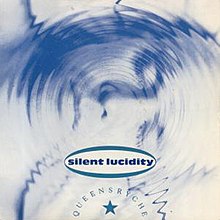1991 single by Queensrÿche
"Silent Lucidity" is a power ballad [4] [6] American rock band Queensrÿche from the 1990 album Empire Chris DeGarmo , was the biggest hit for the band, peaking at #9 on the Billboard Hot 100[7] Billboard Album Rock Tracks chart.[8]
Meaning and music [ ] Because of the lyrical content, and the title of the song, it is assumed to be based on the subject of lucid dreaming . During the middle eight , a distorted voice even explains a method for this: "Visualize your dream. Record it in the present tense. Put it into a permanent form. If you persist in your efforts, you can achieve dream control."
The song was recorded with sweeping orchestrations. Often the orchestra is not relegated to the background but instead is prominent such as during the second half of the instrumental section.
At the end of the song (5:26), a cello or double bass plays the theme from the traditional Brahms' Lullaby — the typical English translation words being "Lullaby, and good night, go to sleep, little baby".
Track listing [ ] Original 1991 release [ ] "Silent Lucidity" – 5:49
"The Mission" [Live] – 6:17
"Eyes of a Stranger [Live] – 8:03 Chart performance [ ] Weekly charts [ ] Year-end charts [ ] Personnel [ ] Additional personnel [ ] Accolades [ ]
Publication
Country
Accolade
Rank
Classic Rock
US
The 40 Greatest Power Ballads[4]
36
Glide Magazine
US
Favorite Hair Metal Power Ballads[5]
6
VH1
US
Greatest Power Ballads[6]
21
See also [ ] List of Billboard Mainstream Rock number-one songs of 1991 References [ ]
^ Boehm, Mike (June 27, 1997). "Metal and Its Byproducts : Queensryche Upgrades the Machinery Without Undergoing a Retrofit or Total Conversion" . Los Angeles Times . Retrieved February 24, 2021 . ^ Criblez, David J. (November 11, 2016). "Three lead singers take LI solo flights" . Newsday . Retrieved June 28, 2021 . ^ Erlewine, Stephen Thomas . "Queensrÿche | Biography & History" . AllMusic . Retrieved February 2, 2021 .^ Jump up to: a b c "The 40 Greatest Power Ballads" . Classic Rock ^ Jump up to: a b Bernstein, Scott (January 4, 2007). "THE B List: Favorite Hair-Metal Power Ballads" . Glide Magazine . Retrieved February 24, 2021 . ^ Jump up to: a b "Greatest Power Ballads" . VH1.com . MTV Networks. Archived from the original on November 13, 2006. Retrieved August 7, 2020 .^ Jump up to: a b "Billboard Hot 100" . Billboard . Retrieved 2021-06-25 .^ Whitburn, Joel (2004). The Billboard Book of Top 40 Hits (8th ed.). Billboard Publications. p. 514.^ "Mainstream rock" . Billboard . Retrieved 2021-06-25 .^ "Radio Songs" . Billboard . Retrieved 2021-06-25 .^ "RPM Top 100 Singles - June 8, 1991" (PDF) . collectionscanada.gc.ca .^ Jump up to: a b "Queensrÿche" . officialcharts.com . Retrieved August 7, 2020 .^ "RPM 100 Hit Tracks of 1991" . RPM . Retrieved November 23, 2017 .^ "1991 The Year in Music & Video: Top Pop Singles". Billboard . Nielsen Business Media. 103 (51): YE-14. December 21, 1991.
External links [ ] show Studio albums Unofficial album EPs Live albums Compilation albums Videography Singles Concert tours Related
Category
Authority control
